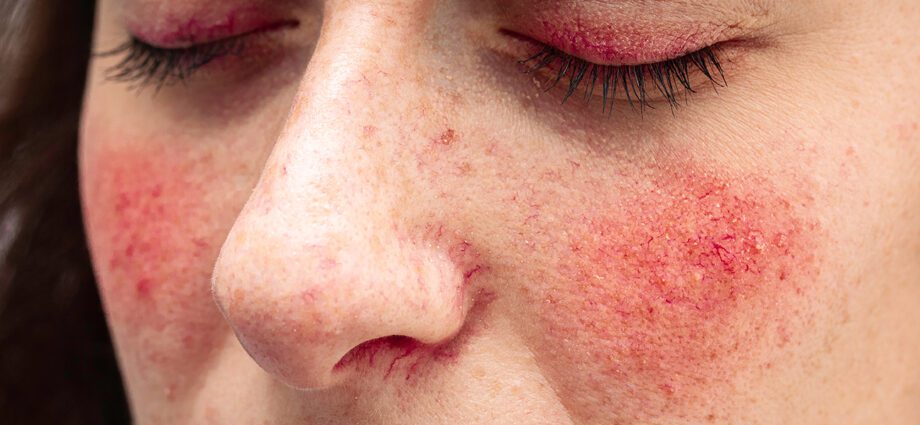Contents
rosacea
La rosacea is a chronic skin condition manifested by rash on the cheeks, nose, then forehead and chin. As the disease progresses, this redness becomes permanent, small dilated vessels (telangiectasias or rosacea) appear on the cheeks and wings of the nose, as well as small red pimples (papules).
Rosacea usually begins around the age of 30 and mostly affects people who have fair skin and eyes and a tendency to blush easily.
It is a condition that gets worse over the years, especially if it is not treated well. In many people, symptoms develop cyclically, with periods of worsening alternating with periods of remission.
Long called acne rosacea, rosacea should not be confused with acne that occurs in adolescence. Blackheads and white pimples are almost absent, and the course of the disease differs. In addition, the factors causing these two conditions are very different. |
Prevalence
La rosacea can affect anyone between the ages of 20 and 70, but adults between the ages of 30 and 50 with the clear complexion and whose skin tends to redden easily are more often affected. From 3% to 10% of the population would be affected by rosacea, to varying degrees. In Canada, more than 2 million people suffer from rosacea.
Women are more prone to rosacea than men, the latter being more likely to develop rhinophyma, which is characterized by a red, swollen, and bumpy nose. This is a very advanced stage of the disease.
Very rarely, rosacea can appear in children, in the form of redness mainly affecting the cheeks. At this age, it is common for eye symptoms (red eyes, swollen eyelids) to precede skin problems.
Causes
The causes are unknown, but according to research1, rosacea could be attributed to:
- a disturbance of the immune system concerning the skin;
- “hyperresponsiveness” of the blood vessels in the face, which dilate excessively. This is what creates the redness and the feeling of heat;
- microorganisms (bacteria or mites of the type Demodex folliculorum);
- an abnormal reaction of the skin to the sun.
Contrary to popular belief, alcohol does not cause rosacea, although even moderate alcohol consumption can worsen.
Certain diseases affecting the skin, such as lupus or scleroderma, can be accompanied by lesions of the skin similar to those of rosacea (telangiectasias, redness). It is therefore essential to see a doctor to confirm the diagnosis.
Finally, the continual application to the face of cortisone cream can cause skin lesions that are visually identical to those of rosacea. In this case, it is rosacea induced by corticosteroid therapy and treatment must be stopped.
Evolution of rosacea
Rosacea progresses differently from person to person. Four subtypes have been established2, which were previously considered to be the different phases of the disease. However, the disease never progresses to its ultimate stage in many people, and most patients have a combination of subtypes. It is therefore impossible to predict the course of the disease.
Subtype 1: erythematotelangiectatic rosacea
- Access of redness on the face and cou, after a meal, after consuming alcohol or hot drinks or even when the temperature changes. These attacks of redness, called flushing or congestives (flushes), last a few minutes, then disappear. This is often the first symptom of rosacea.
- Redness (erythema) permanently present on the central area of the face, especially on the cheeks, nose and middle of the forehead.
- Small vessels under the epidermis become visible and create fine red lines, especially on the cheeks and the wings of the nose. This is called telangiectasia or rosacea. The redness of the skin may mask them, but the red lines usually reappear when the redness subsides.
- The skin can become slimming, rough, with burning and tingling sensations.
Subtype 2: papulopustular rosacea
- Small red and solid buttons (papules) or filled with pus (pustules) besiege the face, adding to the erythema.
- Telangiectasia may be present.
- The redness persists in the central area of the face.
Subtype 3: phymatous rosacea
- This is the subtype with the most marked symptoms. The oil glands in the nose increase in size, the pores dilate, and the skin thickens, forming fleshy protuberances or blisters (nodules). The nose is the part of the face that suffers the most deformation. This hypertrophy, called rhinophyma, affects men more (95% of cases) than women and occurs after 50 years. Rhinophyma requires surgical correction.
Subtype 4: ocular rosacea
- This subtype is characterized by a eye irritation, which become red and dry, with excessive tearing and sensitivity to light. The ocular rosacea affects more than half of people with rosacea. The other symptoms are conjunctivitis and inflammation of the eyelids (blepharitis). The irritation remains minimal in the majority of cases. If the situation worsens, it is necessary to intervene quickly or else to cause a sharp decrease in vision.
- Ocular rosacea is sometimes the precursor to the first skin symptoms.










